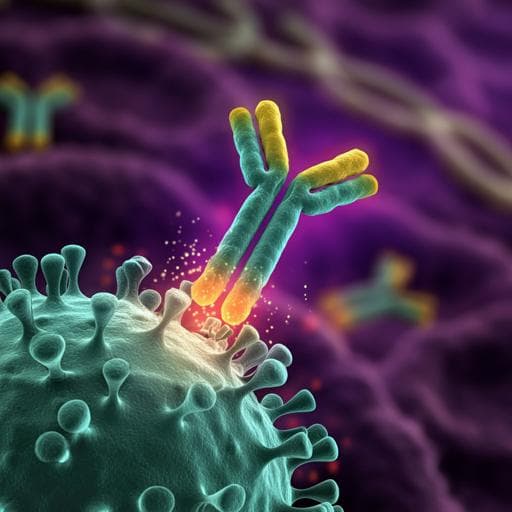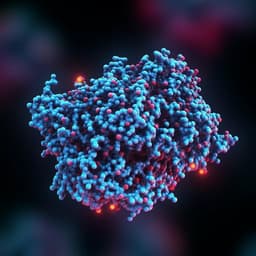
Medicine and Health
Identification of a cross-neutralizing antibody that targets the receptor binding site of H1N1 and H5N1 influenza viruses
T. Li, J. Chen, et al.
Discover groundbreaking research on the chimeric monoclonal antibody C12H5, which not only neutralizes seasonal and pandemic H1N1 viruses but also offers cross-protection against certain H5N1 viruses. This innovative work by Tingting Li, Junyu Chen, Qingbing Zheng, and colleagues showcases potential advances in antiviral drugs and broad-protection influenza vaccines.
~3 min • Beginner • English
Introduction
Seasonal and pandemic influenza A viruses, particularly H1N1 and H5N1, continue to cause substantial morbidity and mortality worldwide, with historic pandemics and recent zoonotic outbreaks (e.g., H5N1, H5N6, H7N9) highlighting pandemic potential. While vaccines are the most effective countermeasure, antigenic drift leads to strain mismatch and variable efficacy, creating a need for next-generation vaccines and therapeutics with broad and cross-type protection. Broadly neutralizing antibodies (bnAbs) predominantly target hemagglutinin (HA), mediating virus attachment via the receptor-binding site (RBS) and fusion via the HA2 stem. Prior bnAbs targeting the HA stem (e.g., CR6261, CR9114) can cross-protect across groups, whereas some head-directed bnAbs offer potent neutralization but often with narrower breadth. This study seeks to identify and structurally define an antibody that broadly neutralizes H1N1 and cross-neutralizes H5N1 by targeting conserved elements in the HA RBS, informing therapeutic and vaccine design.
Literature Review
The authors review that there are 18 antigenically distinct HA subtypes (H1–H18) and that heterosubtypic bnAbs can target conserved regions. Stem-directed bnAbs such as CR6261 (group 1) and CR9114 (A and B) demonstrate broad protection. Fewer cross-subtype antibodies target the HA head; examples include C05, S139/1, and F045-092, reported to cross-react with H1, H2, and H3. H1 head-directed bnAbs CH65, 5J8, and Ab6649 target H1 but lack cross-subtype activity; CH65 and 5J8 target the RBS, with 5J8 and Ab6649 broadly neutralizing seasonal and pandemic H1N1. These precedents suggest head-targeted bnAbs can be potent and immunodominant but often with limited breadth, motivating discovery of head-directed antibodies with broader cross-type coverage.
Methodology
- Antibody generation: Mice were sequentially immunized intranasally or subcutaneously with live seasonal H1N1 viruses (HK/1994, NC/1999, BR/2007). Hybridomas were generated and screened by hemagglutination inhibition (HAI) and microneutralization (MN) assays. Mouse mAb 12H5 (IgG1) was selected for breadth and potency. Variable regions (VL, VH) were sequenced (aligned to KV3-4 and HV9-1 germline). A human-mouse chimeric antibody, C12H5 (mouse variable regions with human IgG1 Fc), was constructed and expressed in CHO cells; other comparator bnAbs (5J8, CH65, Ab6649, CR6261, F10, F16) were similarly chimerized.
- In vitro binding: ELISA measured binding to recombinant HAs from seasonal H1N1, pandemic H1N1, H5N1, and influenza B (control). Surface plasmon resonance (SPR) quantified kinetics/affinities (ka, kd, KD). Immunofluorescence detected binding to MDCK cells infected with selected H1N1/H5N1 strains.
- Neutralization assays: HAI and cell-based MN assays were performed across panels of H1N1 (1991–2015) and H5N1 strains. Comparative neutralization with chimeric bnAbs was assessed. Egress inhibition assays measured released virus in supernatants by hemagglutination units after incubation with antibody.
- In vivo efficacy: BALB/c mice (6–8 weeks, n=5/group) received C12H5 prophylactically (24 h before) or therapeutically (24 h after) against lethal mouse-adapted H1N1 (MA-NC/1999, MA-CA4/2009) and H5N1 (MA-QH/2005). Doses ranged from 1–20 mg/kg. Outcomes: survival, body weight, and lung virus titers (TCID50) at day 6. Comparative therapeutic efficacy versus other bnAbs was tested (3 mg/kg for MA-CA4/2009; 15 mg/kg for MA-QH/2005).
- Structural studies: X-ray crystallography of 12H5 Fab bound to CA4/2009 HA head (3.1 Å) and cryo-EM of 12H5 with BJ/1995 HA trimer (3.14 Å) to define epitope, binding orientation, and interactions (CDR engagements, hydrogen bonds, salt bridges). Structural comparisons with RBS-directed bnAbs (5J8, CH65, CH67, Ab6649; H5 bnAbs FLD21.140, AVFluIgG03) and receptor analog complexes (LSTc α2,6 for H1; LSTa α2,3 for H5) to assess receptor mimicry.
- Mutagenesis and escape: Selection of C12H5 escape mutants in multiple H1N1 strains identified substitutions in the 140-loop region. Alanine-scanning and specific substitutions at 15 epitope-contact residues assessed via ELISA and SPR to identify critical residues. For H5N1, natural variant residues (S133a, A137, Q142, R144, S145) were mutated (QH/2005 background) to probe binding effects. Position 190 D/E swapping between H1/H5 tested for tolerance.
- Human sera assays: Blocking ELISA measured interference of human anti-H1N1 infection sera (n=5, RNA positive) with C12H5 binding to HAs and sensitivity of sera to key HA point mutations.
- Immunogen pilot: KLH-conjugated peptides comprising contiguous regions of the C12H5 epitope (R1 K133a–V155; R2 H183–L194) from CA4/2009 and QH/2005 were used to immunize mice (prime-boost at weeks 0, 2, 4). Sera were assessed for blocking of C12H5-HA binding and HA reactivity; survival after lethal challenge was recorded.
Key Findings
- Breadth and potency in vitro: C12H5 bound H1N1 and H5N1 HAs with EC50 values 7.9–186.5 ng/mL (ELISA). SPR KD values: 8.1 nM (H1 A/Beijing/262/1995), 24.85 nM (H1 A/California/04/2009), 127 nM (H5 A/Bar-headed Goose/Qinghai/15C/2005). C12H5 showed HAI activity against most seasonal H1N1 (except SI/2006, BR/2007), moderate HAI against pandemic H1N1, and measurable HAI against three H5N1 strains. MN assays showed broad neutralization across all representative H1 strains (median IC50 5.75 µg/mL) and cross-neutralization of H5N1; C12H5 displayed broader breadth than 5J8 and CH65 and greater overall potency than Ab6649 and stem bnAbs CR6261, F10, F16 in this panel.
- In vivo protection: Passive transfer of mouse mAb 12H5 provided dose-dependent protection against lethal MA-CA7/2009 (pdm H1N1) and MA-QH/2005 (H5N1): 5 mg/kg yielded 100% survival; 2.5 mg/kg yielded 50–60% survival. Chimeric C12H5 prophylaxis: ≥2.5 mg/kg fully protected against MA-NC/1999 and MA-CA4/2009; 1 mg/kg achieved 80% survival. Against MA-QH/2005, 10 mg/kg fully protective; 2.5 mg/kg gave 60% survival. Therapeutically, ≥5 mg/kg fully protected against MA-NC/1999 and MA-CA4/2009; 1 mg/kg gave 80% survival for MA-CA4/2009. For MA-QH/2005, ≥10 mg/kg fully protective; 5 mg/kg yielded 80% survival; 1 mg/kg 60% survival. Lung viral titers were significantly reduced versus control.
- Mechanism: C12H5 inhibits viral entry into MDCK cells (consistent with HAI) and blocks egress at 0.1 mg/mL across tested H1N1 and H5N1 strains (no effect on influenza B control), indicating dual inhibition of attachment and release.
- Structural epitope and receptor mimicry: 12H5 binds the HA RBS with a footprint overlapping the 130-loop, 140-loop, and 190 helix; 15 hydrogen bonds and 2 salt bridges; buried surface ~827 Å2. The binding orientation is more membrane-proximal and uniquely covers the 140-loop compared with 5J8/CH65. LCDR1 penetrates the RBS, mimicking human (α2,6 LSTc) and avian (α2,3 LSTa) receptor interactions via Y32 and F30a, with hydrophobic contacts to W153, V/I155, L194 and hydrogen bonds to V135–A/S137 and D/E190.
- Critical residues: Eight key H1 residues essential for binding/neutralization were identified: Y98, A137, H141, A142, G143, A144, W153, D190. Mutations Y98A, A137E, H141A, A142E, G143R, A144E, W153A, D190A abolished binding (EC50 >100× WT; SPR undetectable). Many are highly conserved (>90%); A142 and A144 showed moderate conservation (77.4%, 73.2%). Position 190 D/E polymorphism was tolerated: CA-D190E and QH-E190D retained binding with 5–10× reduced activity.
- H5 determinants: In H5N1 QH/2005 HA, Q142L, R144N, S145P abolished binding, indicating Q142, R144, S145 as key sites (moderately conserved ~67% among H5N1). S133aL and S137A modestly reduced binding (~2× EC50).
- Escape mutants: Under C12H5 pressure, escape variants arose in the 140-loop region (e.g., G143R, K144T, N142D, A142E) across multiple H1N1 strains, mapping to the defined epitope.
- Human sera: Blocking ELISA with H1N1-infected human sera (n=5) showed mean blocking rates of ~39.2% (C12H5) and 40.2% (F16) for CA4/2009; 18.8% (C12H5) and 30.4% (CH65) for NC/1999, suggesting medium-frequency bnAb-like responses. Human sera showed significantly reduced titers against HA mutants at key C12H5 epitope residues (e.g., A142E, G143R, A144E, W153A, D190A).
- Immunogen pilot: KLH-conjugated peptides comprising C12H5 epitope segments elicited sera that blocked C12H5-HA binding (37–60%) and reacted with HA; limited in vitro neutralization observed, but partial survival (20–40%) in lethal challenge suggested immunogenicity of the epitope construct.
Discussion
The study addresses the need for broadly protective influenza interventions by identifying and characterizing C12H5, a head-directed RBS-targeting antibody with broad H1N1 neutralization and partial H5N1 cross-neutralization. Mechanistically, C12H5 inhibits both entry and egress, and structurally targets a conserved RBS epitope that uniquely extends over the 140-loop, a feature distinguishing it from other H1 RBS-directed bnAbs (e.g., 5J8, CH65) and potentially underpinning its cross-subtype breadth. The antibody’s receptor mimicry via LCDR1 engagement and tolerance of the D/E190 polymorphism, a determinant of human versus avian receptor specificity, support its ability to recognize both H1 and H5 RBS architectures. The identification of eight critical, largely conserved H1 residues and key H5 positions (Q142, R144, S145) provides a structural blueprint for vaccine antigens and antiviral design. Comparative in vitro and in vivo data show C12H5 achieves broader coverage than other head bnAbs and comparable or superior protection versus several stem bnAbs, emphasizing its translational potential. The epitope’s conservation and immunogenicity support strategies to focus immune responses to this site in next-generation, broadly protective vaccines.
Conclusion
C12H5 is a chimeric monoclonal antibody that broadly neutralizes seasonal and pandemic H1N1 and cross-neutralizes select H5N1 strains by targeting a conserved RBS epitope that uniquely includes the 140-loop. It provides potent prophylactic and therapeutic protection in mice, inhibits both viral entry and egress, and tolerates the host-specific D/E190 polymorphism. Structural analyses reveal receptor-mimicking interactions and define eight critical H1 residues and three key H5 residues for binding. These insights suggest C12H5 as a template for antiviral development and inform vaccine design focusing on conserved RBS features. Future research should optimize epitope-focused immunogens to enhance breadth and potency, assess efficacy across broader H5N1 clades and other subtypes, and advance toward clinical evaluation.
Limitations
- Cross-neutralization of H5N1 was partial and required higher doses for full protection; affinity to H5 HA was moderate (KD ~127 nM) with faster off-rates, potentially limiting potency in some assays.
- Neutralization potency varied across H1N1 strains; certain seasonal strains (e.g., SI/2006, BR/2007) lacked HAI activity.
- Human serology involved a small cohort (n=5) and lacked H5N1 convalescent sera; blocking assays indicate medium-frequency bnAb-like responses but do not establish protective efficacy in humans.
- Structural crystallography used a degraded HA head in the asymmetric unit (though congruent with trimer structures), and in vivo studies were limited to mouse models.
- Peptide immunogen pilot elicited binding and partial protection but no robust in vitro neutralization, indicating further immunogen optimization is needed.
Related Publications
Explore these studies to deepen your understanding of the subject.







